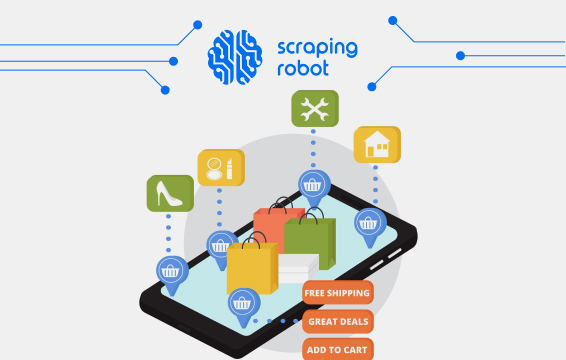eCommerce APIs (How They Work And Why You Need One)

Looking to the eCommerce industry, data-driven insights can give you limitless ways to better serve your customers, optimize your procedures, and enter new sectors with the proper resources. You also want to get your hands on the data you need when you need it. An eCommerce API can transfer data from one website to another with a single user interface. With all the time and effort you put into running your company, the last thing you have time for is trying to build these features from scratch. Web scraping can get you this information quickly and efficiently, all with a single click through the use of an API. Continue reading to learn more about what an eCommerce API is, how it works, and the benefit it can have on your business.
Do you have a specific question in mind? Please feel free to utilize our helpful table of contents listed below.
Table of Contents
2. What Are the Benefits of Using an API for eCommerce?
4. eCommerce API Integration (How to Set it Up)
What is an eCommerce API?

An application program interface, or API, is a set of functions that delivers a user’s response to a website before sending the website’s response back to them. For example, if you fill out a form on a company’s website, you’re sending information to the system upon completion. When the system receives that information and sends it back to you, it will do so in the form of a confirmation that your submission was received.
Another example is if you purchase on a website. After your purchase is complete, you will receive a message from the website saying that your order has been confirmed. These are common examples of how an API works, specifically how an eCommerce API works.
What Are the Benefits of Using an API for eCommerce?

There are multiple benefits of using an API for your eCommerce industry. First and foremost, an eCommerce API allows you to connect different platforms (such as your shipping provider’s information, labeling, invoicing, and tracking information), which helps streamline the process.
Second, eCommerce APIs can be used more than once. This means that if you create a new brand or website or connect new features, you can do so without starting from scratch. Most importantly, an eCommerce API allows you to pick and choose the elements you want for your store from other applications to design an API specifically customized to fit your business needs.
Additional benefits of an eCommerce API include:
- The ability to help you complete your tasks faster and more efficiently
- The ability to connect to a new system without having to make any changes to your website’s original program
- Security protection to ensure personal data such as payment transactions remain secure on your site
As you can see, there are many different benefits to using an eCommerce API. Now that we’ve covered the benefits let’s explore the different types that will work best for your eCommerce business.
Kinds of API eCommerce

While there are hundreds of APIs you can choose from on the market, not all of them are created equal. Below, we look at some of the most common and what kind of benefit they will have on your business. The most common types of eCommerce APIs include:
- Marketing API
- Payment API
- Validation API
- Orders API
- Shipping API
- Product information API
Below, we’re going to explain what each of them is and how it can benefit your business.
What is a marketing API?
If you have any email marketing needs, a marketing API can help. With this particular type of API, you can create segmented email lists based on your customer’s historical data, such as their location and purchasing history. This enables you to target customers about products they’re most likely to engage with and have a high return on investment.
What is a payment API?
A payment API allows you to accept your customers’ payment, either via credit or debit card. The good news is that a payment API can be used in conjunction with an existing payment gateway listed on your website.
What is a validation API?
With a validation API, you’ll be able to eliminate the hassle of verifying your customers’ information. This type of API will verify your customer’s name, address, email address, and any other pertinent information they entered into a form on your website. After a customer submits their information or payment on your website, this API will determine whether or not this is an existing or new customer, making it easier to segment them for your marketing strategy later on down the line.
What is an order API?
An order API allows you to view all of your active orders in one place, all of which can be sorted based on the date it was ordered or shipped out to a customer. It can also allow you to create bulk orders and process returns and cancelations with ease.
What is a shipping API?
With a shipping API, you can automate the shipping process from start to finish. This means you can create shipping labels and invoices and even track how long it takes for an item to reach your customer. A common example of this can be found on the website Etsy, which allows users to do everything mentioned above without manually entering a tracking number once they ship a product.
What is a product information API?
Finally, we have the product information API, which allows you to pull data about your inventory, including the product description, images, prices, and more.
Scraping Robot offers tools to obtain this information from your competitors
Speaking of product information, how great would it be to be able to pull all of that information from your competitor’s site so you can know, in real-time, when they’re offering a sale or promotion? With Scraping Robot’s web scraper API, you can do just that. Web scraping allows you to efficiently and effectively pull vital data from any website.
With our product, you’ll be able to download product descriptions and prices from major websites. We also offer our clients 5,000 free scrapes per month. You can learn more about our API process here.
eCommerce API Integration (How to Set it Up)

To perform an eCommerce API integration, it’s important to keep these three main tips in mind:
- First and foremost, you have to identify your goals of an eCommerce API integration – i.e., what are you looking to gain from this, and how can an API streamline your workflow?
- Second, you need to consult with your system administrators and software analysts to determine how an API integration will meet these goals and what you’ll need to complete this task.
- Third, you need to work with your development team to run tests on your system to make sure it can handle the integration and address any issues before moving forward.
Once you’ve worked through these three steps, you’re ready to implement an eCommerce API integration with the help of an API integration management platform. When selecting an API management platform, you want to make sure they can scrape the websites you want and that you aren’t being charged money for any unsuccessful reports. At Scraping Robot, not only can we help you scrape any website thanks to our HTML scraper, but we won’t charge you any money if a scrape is unsuccessful.
While identifying your goals and devising a game plan is an important step your eCommerce business should take to help streamline the process, doing your research about the best API management platform can’t be understated. As a business owner, your time is valuable, which is exactly why we offer a free demo so you can see how beneficial our web scraping API can be for your eCommerce business.
Final Thoughts

We covered a lot of important information in this article, all of which touts the benefits of using a web scraper API for your eCommerce business. With the advent of the internet and social media, the eCommerce industry has flourished, with online shoppers expected to generate “$230.5 million [worth of revenue] in 2021.” Having an online store that can streamline everything that goes into buying and sending out merchandise can’t be understated. With the help of an eCommerce API, you’ll be able to streamline your buying and selling process unlike ever before, including when to re-adjust your strategy as soon as your competitors lower their prices. As a customer’s buying habits continue to evolve, you need an affordable, reliable API that can keep up with market demands to ensure your eCommerce business’s continuing success.
The information contained within this article, including information posted by official staff, guest-submitted material, message board postings, or other third-party material is presented solely for the purposes of education and furtherance of the knowledge of the reader. All trademarks used in this publication are hereby acknowledged as the property of their respective owners.
